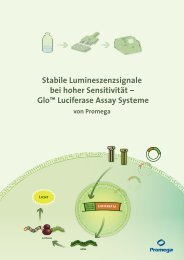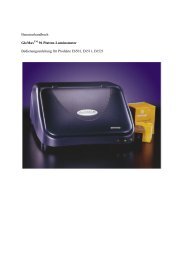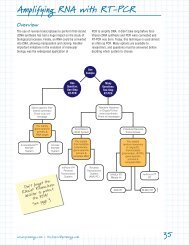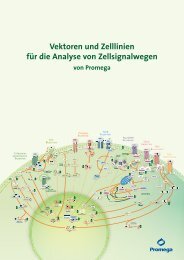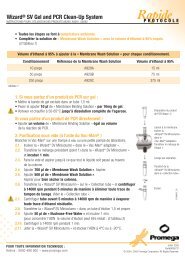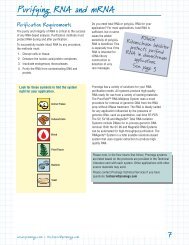The Role of Cell-Free Rabbit Reticulocyte Expression ... - Promega
The Role of Cell-Free Rabbit Reticulocyte Expression ... - Promega
The Role of Cell-Free Rabbit Reticulocyte Expression ... - Promega
Create successful ePaper yourself
Turn your PDF publications into a flip-book with our unique Google optimized e-Paper software.
<strong>The</strong> <strong>Role</strong> <strong>of</strong> <strong>Cell</strong>-<strong>Free</strong> <strong>Rabbit</strong> <strong>Reticulocyte</strong> <strong>Expression</strong> Systems in Functional Proteomics<br />
by caspase‑8, BID reveals an N‑myristoylation site. RRL contains the components necessary<br />
to complete N‑myristoylation, and has even been used to myristoylate tumor necrosis factor, a<br />
normally nonmyristoylated protein, when it is modified to contain the N‑myristolyation motif<br />
<strong>of</strong> other myristoylated proteins. 44,45 <strong>The</strong> Arabidopsis SOS3 protein involved in plant salt tolerance<br />
has also been synthesized and myristoylated in an RRL system. 46<br />
N‑Acetylation<br />
A majority (70–85%) <strong>of</strong> the proteins found in the cytoplasm or nucleus <strong>of</strong> eukaryotes may be<br />
modified by N‑acetylation. 47,48 Examples <strong>of</strong> N‑acetylated proteins include ovalbumin, actin and<br />
cytochrome c. Acetylation is catalyzed by N‑acetyltransferases cotranslationally after the initiator<br />
methionine has been cleaved. 48 Many proteins are also acetylated post‑translationally at internal<br />
sites by acetyltransferase enzymes different from those involved in cotranslational modification. 48<br />
Acetylation <strong>of</strong> modified tumor necrosis factor (TNF) has been demonstrated in RRL, 47 and acety‑<br />
lation in RRL can be inhibited by the use <strong>of</strong> S‑acetonyl‑CoA, an analog <strong>of</strong> acetyl‑CoA. 49<br />
Reconstituting ER‑Associated Protein Degradation<br />
Conditions such as environmental stress, viral infection and the absence <strong>of</strong> required partner<br />
proteins can result in the accumulation <strong>of</strong> aberrantly folded proteins in the rough endoplasmic<br />
reticulum (RER). <strong>The</strong> RER has a “quality control” system that targets these misfolded proteins<br />
for degradation. This process, ER‑Associated Degradation (ERAD), requires ATP and is distinct<br />
from the lysosomal degradation pathway in cells. 50<br />
RRL in conjunction with CMMs or SP cells has been used to reconstitute ERAD activity.<br />
RRL has several advantages over intact‑cell systems for such study. <strong>The</strong> protein <strong>of</strong> interest will be<br />
the only protein labeled in the RRL, making its degradation easy to follow. 51 Second, a variety<br />
<strong>of</strong> microsomal membranes can be used with RRL to reconstitute the activity. 15,51 Because hemin<br />
inhibits the proteasome activity <strong>of</strong> ERAD, degradation studies are best performed in RRL that<br />
does not contain exogenous hemin. Researchers have reported that RRL that works well for studies<br />
<strong>of</strong> degradation is usually poor for translation. 51 Additionally, since ERAD is ATP‑dependent, the<br />
RRL will need to be supplemented with ATP and an ATP regeneration system, 51 and some authors<br />
report that excess unlabeled methionine seems to aid in reconstituting ERAD activity. 52<br />
RRL‑based protein degradation systems have been used to investigate the synthesis, stability<br />
and degradation <strong>of</strong> a variety <strong>of</strong> wild type and mutant proteins. In one such study, tyrosinase<br />
ERAD was reconstituted in a commercially available RRL system supplemented with an ATP<br />
regeneration system. 53 Wild type and mutant tyrosinase associated with albinism were translated<br />
in the presence <strong>of</strong> SP melanocytes; the SP cells were isolated and then resuspended in RRL<br />
with the ATP regeneration system. Both proteins were degraded, although the mutant protein<br />
degraded at a higher rate than the wild type protein. RRL‑based and rat cytosol‑based degra‑<br />
dation systems have also been used to investigate the degradation <strong>of</strong> Apoprotein B (apoB). 54<br />
Aliquots <strong>of</strong> the transcription/translation reaction <strong>of</strong> HA‑tagged apoB were incubated in the<br />
presence <strong>of</strong> an ATP regeneration system in fresh RRL or rat hepatocyte cytosol with or without<br />
proteasome inhibitors. Inhibition <strong>of</strong> apoB degradation was more obvious in the rat hepatocyte<br />
cytosol, presumably because RRL contains factors that interfere with the proteasome inhibitors.<br />
To assess the role <strong>of</strong> the chaperone protein, hsp90, in the degradation <strong>of</strong> apoB48, geldanamycin<br />
(GA), an antibiotic that competes for the ATP binding site on hsp90, was added to pelleted<br />
CMMs before the degradation assay. <strong>The</strong>re was no significant decrease in the amount <strong>of</strong> apoB48<br />
in the presence <strong>of</strong> GA, indicating that GA did inhibit degradation and hsp90 was required for<br />
apoB48 degradation. 54<br />
RRL has been used to reconstitute the degradation <strong>of</strong> α 1‑antitrypsin Z [(α 1AT)Z]. 52 Individuals<br />
who are homozygous recessive for a mutation resulting in a Glu 342 to Lys substitution have increased<br />
susceptibility to liver disease. 52 <strong>The</strong> amino acid substitution disrupts proper folding <strong>of</strong> (α 1AT)Z,<br />
and individuals susceptible to the liver disease are not able to degrade the misfolded protein effi‑<br />
ciently. Mutant and wild type (α 1AT)Z degradation were examined using an RRL degradation assay<br />
system. <strong>The</strong> mutant (α 1AT)Z was degraded efficiently. Mutant protein produced in the presence<br />
15, 51





